

Links to articles, videos, and slideshows on the Apocalypse Mural restoration
Hopkins media department created this terrific 360-degree virtual tour of the mural here and you can access our photo gallery of the restoration here and the celebration for the official opening here.
Read some of the terrific articles the university has written about the restoration and the opening tour of the mural, such as: It's (Not) the End of the World as We Know It; Rising with 'Dr. Bob': Seeing Apocalypse through the artist's eyes; and The Apocalypse then and now: JHU's massive 1960s mural gets a much-needed makeover.
Details on the restoration progress came out in three newsletters: June 2015, August 9, 2015, and August 20, 2015.
The most complete interpretation of the Apocalypse mural is found in the 72-page bound and glossy guidebook published in 2016 in full color, complete with foldout panoramas and reproductions of the sketches and notes from the original Hieronimus journals from 1968-69. Order a copy of this book here. Great gift idea!

Check out this terrific short documentary film by Human Being Productions "The Hieronimus Apocalypse Mural: Rising from the Ashes" chronicling the restoration in 2015.
The historic Apocalypse mural by Dr. Bob Hieronimus at Johns Hopkins University, Levering Hall was fully restored in the summer of 2015, and on April 8, 2016 Johns Hopkins hosted an alumni weekend special lecture and tour of the mural. The lecture on the social justice history of Hopkins was followed by a cocktail reception and then a personal tour of the mural by the artist himself. University President Ron Daniels introduced the speakers, honoring Dr. Bob, the mural, and the team of restoration artists, with a sold-out presentation on the history of social activism at Hopkins by historian Bill Leslie.
Johns Hopkins University has enthusiastically embraced Hieronimus's historic piece of artwork, and not only helped to finance the restoration, but also installed new museum-style furniture, new lighting fixtures, and new protection measures for preserving the work in the future.
Contemporary students at Johns Hopkins are being inspired by this mural to activate their own missions for social justice. Ella Rogers-Fett, a Krieger School senior and history major visited the mural for the first time in 2015 and says she and many of her classmates were inspired upon learning about the mural's relationship to a history of student activism at Hopkins. That inspiration resulted in a petition her fellow students started to encourage Hopkins to divest itself from carbon-related stocks to reduce its environmental impact. Recently, Rogers-Fett visited the mural space for a meeting of social justice groups organized by the Center for Social Concern, a division of Homewood Student Affairs.
"I like the idea that student activists of today are meeting there to advance important issues," says Rogers-Fett, who serves as a co-director of the student-run Sexual Assault Resource Unit. "We're continuing the spirit of Apocalypse."
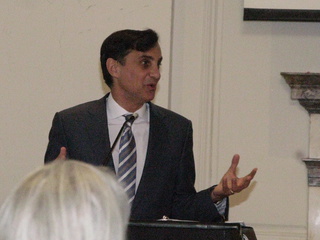
President Daniels speaking
At the mural's official opening event, historian for Johns Hopkins University, Dr. Stuart "Bill" Leslie, Ph.D., treated the audience to a slideshow and talk focused on the legendary chaplain of Hopkins, the social justice pioneer Dr. Rev. Chester Wickwire. Wickwire is also the one who commissioned Hieronimus to paint the original Apocalypse mural. Starting early in the 1950s and lasting beyond his retirement in the 1980s, Dr. Wickwire ensured that the students at Johns Hopkins were engaged in consciousness raising and actively protesting for change in the fields of civil rights, women's rights, and international peace.
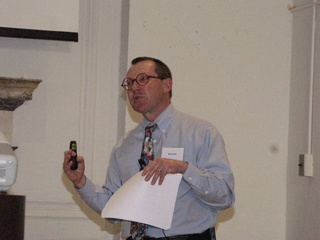
Dr. Leslie speaking
Professor Leslie then introduced Dr. Hieronimus to the podium to share his memories of Dr. Wickwire and his involvement in the birth of the original Apocalypse mural. He explained how "Chet" Wickwire was an early champion of Hieronimus's iconoclastic artwork and status-quo-challenging messages. Wickwire decided to commission Hieronimus to paint a mural outside his office in Levering Hall where the great room served as a hangout favored by students and nicknamed by them "Chester's Place." Hieronimus's memories included several instances of Wickwire defending him from the critics of his controversial artwork, and remaining amused in his belief that it helped to stir things up.
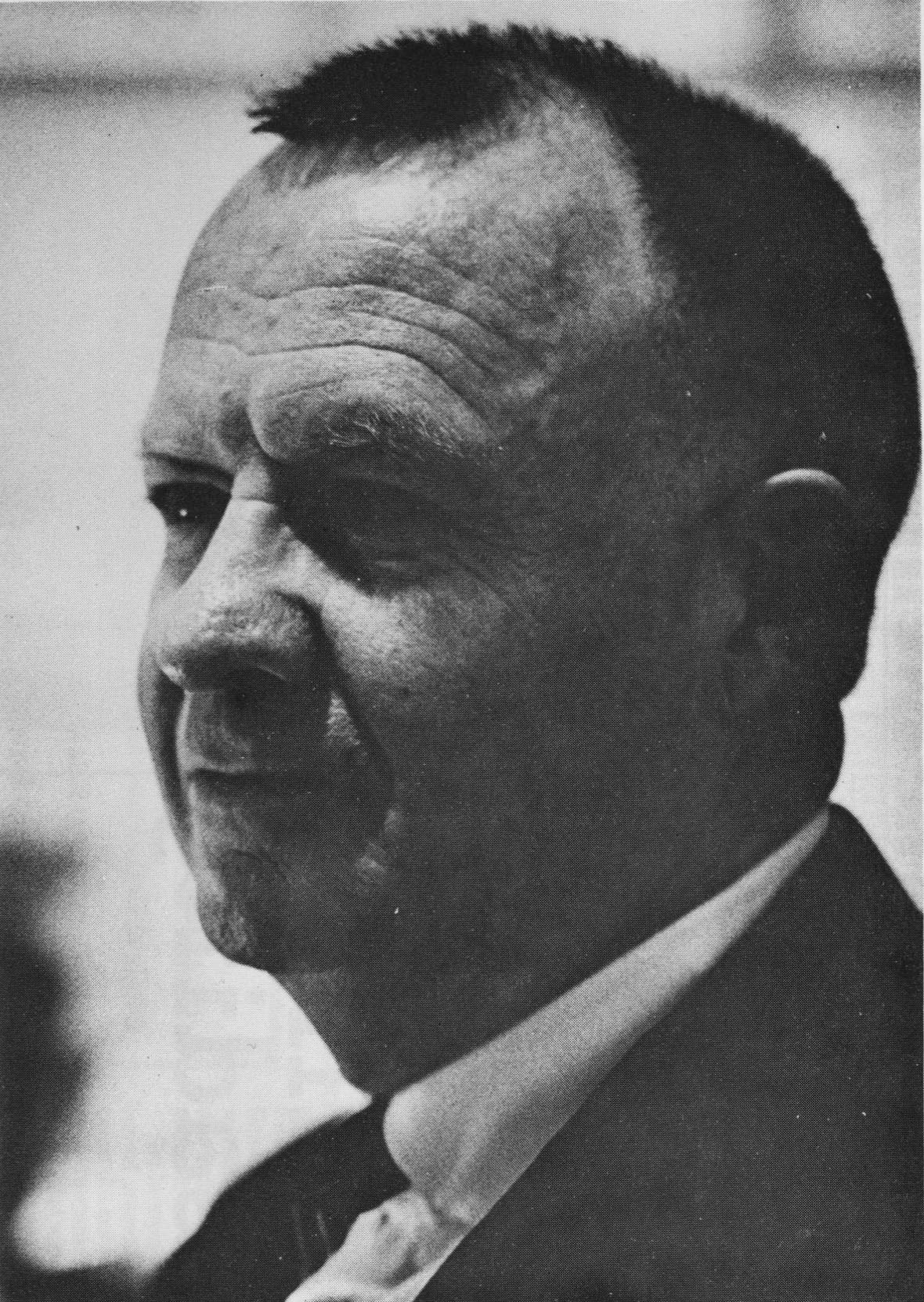
Chester Wickwire
After a brief question and answer period, followed by a cocktail reception, the crowd then moved upstairs to the mural room where they were treated to a one hour lecture tour by the artist himself. Hieronimus pointed out the more significant panels in the 2,700 square feet of the Apocalypse mural and defined the meanings behind many of the symbols in them for the listeners. Footage of this mural interpretation tour can be seen here.
Meanwhile, enjoy this one hour video of the lecture portion of the mural opening event with the slideshow and lecture by Professor Leslie and Dr. Bob Hieronimus's memories of Chester Wickwire commissioning the Apocalypse.
In closing, here is the complete text of Dr. Hieronimus's speech:
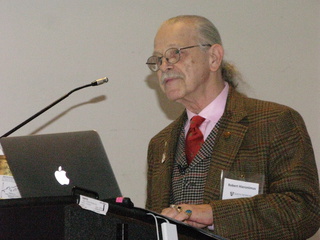
Dr. Bob at the podium
Before I say anything, I want to thank Professor Bill Leslie so very much for your ongoing support of this mural. I also want to thank President Daniels and all of Johns Hopkins for organizing and helping fund the restoration of the Apocalypse mural. Thank you to the Joseph and Harvey Meyerhoff Family Charitable Funds, and especially to my beloved, Zohara Hieronimus, for paying for it. Thank you to my terrific crew of artists for their hard work (many are here today!), and to the many people at Hopkins, especially Ann Koch, Jane Rhyner, Jackie O'Regan, and all the many superior maintenance people at Hopkins – thank you!
Now! A few memories of Chester Wickwire, the Apocalypse, and me... Before painting the Apocalypse mural at Johns Hopkins University I showed a couple of exhibits of my artwork in Levering Hall's Sherwood Room. I had warned Dr. Chester Wickwire (whom I knew as Chet) that some of these works might upset the students and their families, but he said he was pleased that maybe they'd learn something! We never did have any problems with the students, who were quite enthusiastic with what was shown. And most of the faculty were OK with it, too. But there was this one group called "the faculty wives," and they were ready to string me up!
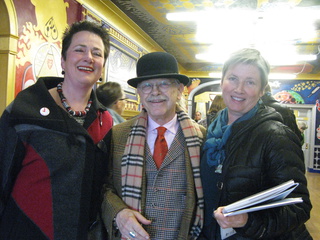
Ann Koch, Dr. Bob, and
Jackie O'Regan
What disturbed them the most were these large constructions that I created that Chester thought were great fun! One was a 12-foot coffin, containing an American Eagle dressed in a General's uniform bearing a crucified Jesus on its chest. On top of that was a crucifix with Mickey Mouse riding it, along with corporate symbols of GE, Coca Cola, Chiquita Banana and slogans saying "Make Sales Sizzle." It was called the American Express. And Chet completely "got it."
The wives of the faculty did not "get it." They wanted so badly to shut down the exhibit they brought in the Maryland Attorney General's Office, who was also chomping at the bit to attack this exhibit they had heard was un-American! They came charging in to bust this young artist with his long hair and scraggly beard, who they thought they were going to teach a thing or two about respecting our flag, our military and our Constitution. I was used to this kind of misunderstanding and attack, but I was worried for Dr. Wickwire, and figured he would probably fold under the pressure. I couldn't have been more wrong.

Dr. Bob and John Astin at Liberty Torch
Chet stood right up for me, and defended my rights as an artist to free speech and all that, but more importantly he took the time to explain what my message was in this work. It was my sincere belief that America was for sale, or actually, in fact it had sold out. I have this great quote from him when he said: "Hieronimus is not attempting to be irreverent. He feels that America, and not himself, has desecrated these symbols."
This allowed me the time to explain how our symbols had been desecrated and to share a little of the farewell speech of President Dwight D. Eisenhower's (whose brother was president of Johns Hopkins at the time!) You all know the one I'm talking about, where he says: "in the councils of government, we must guard against the acquisition of unwarranted influence, whether sought or unsought, by the military industrial complex." Which, of course, today we should call it more like the military-industrial-media complex. All of this controversy only pleased Chet the further, because, as he said, it "livened things up." The Attorney General felt satisfied enough that the matter was dropped, and the exhibit remained open. From that moment forward, I knew I had to find a way to thank this very advanced, courageous, and outspoken soul.
It wasn't long after this that Dr. Wickwire asked me if I wanted to paint a mural on the wall outside his office on the second floor of Levering Hall. The room was known as Chester's Place, a sort of coffee-shop and hang out for students. I was honored at the request, but I had to postpone the commission at first, because I had plans to meet with some record companies to design their record album covers. In early July 1968 I got to spend a little time with Jimi Hendrix, Janis Joplin and the Doors, but it didn't take long to realize that the rock and roll life was was not the life for me. I returned to Baltimore to take up Chester Wickwire's proposal.
Chet showed me the wall and the YMCA gave me a check for $1000, and I began work on what I call today the American eagle wall. As it progressed I looked at all the other blank walls and up at the ceiling, and eventually I asked Chester if I could expand beyond that one wall. I was so surprised he said yes! Well, he said yes, I could keep painting, but nothing more could be added to the budget, so in effect, I painted the entire 2,700 square foot mural for just $1000!
I was fully committed to this painting. I literally moved in to Levering Hall. I brought a sleeping bag and for about six months my entire life was spent painting, eating and sleeping. Dr. Wickwire had no problem with my living there, but after the first few months he did start to ask me "When are you going to be done, Hieronimus?" Amazingly, that was his only complaint throughout the entire procedure.
Others in the building were not so happy I had moved in. One particular overnight custodian in particular took it upon himself to try to get me kicked out. We first ran into each other one morning in the wee hours between 2-3 AM, when I heard someone downstairs, and at first thought it might be a ghost or an alien. It was only this fellow emptying cans and cleaning up. He was none too happy that I was invading his space. He started to check up on me every now and then, coming upstairs to see what I was doing. Then one day he brought a Hopkins policeman with him, and claimed I had a gun and had threatened to kill him. I thought it was a joke, but he was serious and pointed to the so-called "gun" in my pocket. This turned out to be my tobacco pipe that I occasionally smoked from. Then he accused me of hiding my revolver, so I told the officer to search me and all my bags so I could get back to work! He searched everything and found nothing and apologized. After they left, though it felt like the Twilight Zone, I was happy that it was over. But it wasn't over. A couple of weeks later the same employee came upstairs and renewed his claim that I was out to get him. Once again the same policeman came, but this time when I told him he could search me again for this mysterious gun, he refused and left apologetically.
Somehow this story got to Chet, and he thought it was hilarious. It became a running joke for him to ask me for my gun. He seemed to especially like to do this when some of his friends were around. His eyes would light up, and he held back a smile, and I just knew he was enjoying himself teasing me this way. "Where's that revolver, Hieronimus?"
Over the years I have been honored to receive some pretty nice praise for the Apocalypse. I want to read you this one because it was one critic's remarks that Chester particularly liked. Artist critic, and now world-renowned artist Liz Quisgard stated: "If Renaissance Catholicism gave us the Sistine ceiling, Twentieth Century Protestantism has given us ceiling, three walls, and stairwell. It is called The Apocalypse and will be seen (but not quite believed) in Levering Hall on the Hopkins campus from now until Armageddon."
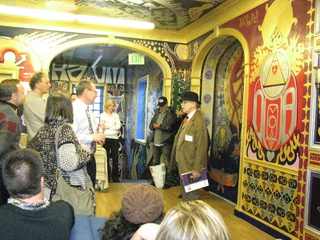
Dr. Bob with crowd in mural room, facing the stairs
Obviously, as a symbolic painter, my work pales in comparison to Michelangelo's, but in fact there are a few parallels to the Sistine Chapel that Dr. Wickwire and others have pointed out. For example, we both had paint thrown on our paintings by fundamentalist critic; our sponsor's lack of cash plagued us both; and we both had to deal with paint falling in our eyes and hair. Michaelangelo probably also heard over and over again like I did: "When will you be finished?" I think he also believed history goes in cycles which is the main theme of my painting.
In closing, I will read to you the dedication I wrote in 1968 that was printed in the very first Apocalypse mural guide. I finally did get to say "Thank you" to him in a very big way, after all: "This mural is dedicated to a man of compassion, peace, and understanding. He is forever under savage attack for his benevolence towards the young. He is a bridge for all generations. He is a Centarian (or Sagittarian). His name is Dr. Reverend Wickwire."
--Bob Hieronimus, Ph.D.
Please check out our photo galleries featuring this opening event and the restoration! Hopkins media department created this terrific 360-degree virtual tour of the mural here and you can access our photo gallery of the restoration here and the celebration for the official opening here.

Left: Bob Hieronimus at the Apocalypse Mural in 1971. Right: At the restored Apocalypse Mural in 2015.
"It's really thrilling to see the mural coming back to life,' said John Astin, Academy Award nominee, actor, and director of the Theatre Arts and Studies Department at Johns Hopkins. "There's creative thinking in that "Apocalypse" mural, and you can't look at it without being stimulated in a very positive way." Hopkins Professor Stuart "Bill" Leslie who is presently writing a new history of the Johns Hopkins University due out in 2018, said "The 'Apocalypse' mural is a good reminder for the current crop of students that their predecessors were out there in the front lines for civil rights, and even gay rights activism." The supervisor of the Photography program for The Center for Visual Arts in the School of Arts and Sciences at Johns Hopkins, Phyllis Berger, says "My times spent there at the mural were pivotal in my growth and helped me become the person that I am." Read more here.

Artist and Project Foreman Justin Williams, Ph.D. and Dr. Bob Hieronimus at the Apocalypse Mural, photographed for the Johns Hopkins Magazine. © Marshall Clarke 2016
Johns Hopkins Magazine featured a story about Dr. Bob and the restoration of the Apocalypse mural in their Summer 2016 edition. Read more.

Steve Boone, bass player for the Lovin' Spoonful, members of the Rock and Roll Hall of Fame, visits the newly restored Apocalypse Mural with artist Dr. Bob Hieronimus in June 2016.